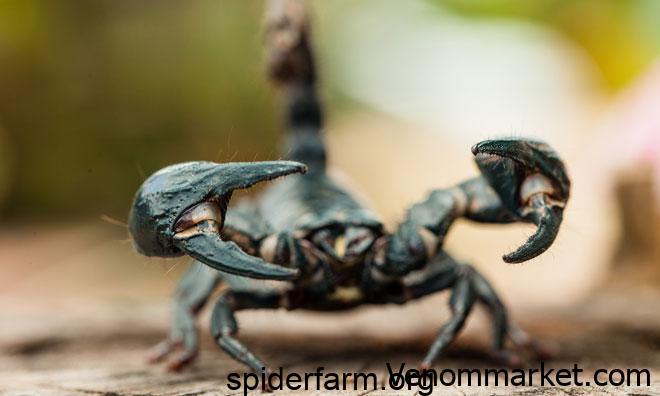Scorpion venom
This scorpion is from the non-digger Botheida family, which has a scorpion length of 100 to 130 mm. In males, the lower part of the body is narrower and longer than females, but the size of the fork gird is the same for both genders. Almost all organs have hair. The back of the legs, the legs, the lateral limbs of the hair. The hair of the knee is very tall. Yellow Scorpion is brownish. The tail end of the tail and the fork usually have a dark and black color.
The first example of this scorpion was identified by Birula in 1905. Global dispersion has been reported in the Middle East and Iran and Iraq. This type of scorpion is non-digging and the trap of the graveyard and the tectonic cleft of stones and other objects are hidden.
The results of the operations in different regions indicate that the activity of the Scorpions began from the late dawn of the month and its maximum activity from June to late October, and gradually decreases its seasonal activity from late October. It should be noted that the Scorpions show no activity in the winter season, due to weather conditions and low temperature of the region. Because the scorpions do not show any activity at temperatures below 4 to 10 ° C.
Hentonetta is a species of scorpions belonging to the family of Bothedee. This species is extensively found in Africa (with the exception of large parts of the Sahara, Africa), including the Arabian Peninsula, South Turkey, Iraq, Iran, Afghanistan, Pakistan, India and Nepal. This species has 34 subspecies, of which 5 subtypes have been reported in Iran.
Scorpion venom

Subcutaneous scorpions have a moderate size, with a scorpion body length of about 70 to 90 mm. The hands and feet, the forearms and the beginning of the tail at the point of attachment to the yellow body and forks, the tail end near the sting and back of the body are dark brown in color and in some cases black. The fork is narrow and the scorpion’s behavior is very violent and aggressive.
This species lives in semi-arid, wet areas and stapes. Dry deserts are not considered by this scorpion, and in some cases up to high altitudes in the Zagros mountains. The venom of this scorpion is similar to the botanical family and the injured person should be under medical care. Reports from injured people indicate the effect of the poison on the respiratory, cardiovascular and respiratory system. The sub-species of the Huttona Tamulus, which is not inhabited in Iran and is known for its Indian scorpion, is the most dangerous poison among the Scorpions, and there are many reports of subsidence-related deaths from India.
Depending on the type of digestive and non-gill scorpion habitat, their probable shelters in the Abu Musa Islands, the large, small, and large Tobb, were investigated using two methods, day search and scorpion collection at night (using ultraviolet light). Samples collected after identification were transferred to the lab and their sex ratio was determined. In the scorpion gathering operation from Abu Musa and the Great Tunb, 311 and 134 scorpions were caught. These scorpions all belonged to the Boutos species. The lack of diversity on the island’s scorpion may be due to various factors, such as the very limited transfer of building materials or planting plants, etc. from the scorpio regions of the country to these areas or the incompatibility of other Scorpio species with the bioecology conditions of the islands Be
Scorpion or scorpion is the name of one of the arthropods of the Spider-Man category, which has 8 legs and a bite with deadly venom. Scorpion bite is at the tip of it. The Scorpions are slowly pursuing their biological activities at night and are more active in hot climates. These animals have spiny claws that are actually part of their mouths. They are able to throw a dangerous toxin from the rear of their bodies to the attackers. The animal hunts more at night and uses its long legs to find food, and after finding food, it catches it with its claws. Sculptures are often hidden under rocks or in the holes of the earth during the day
Scorpion venom

Shape and place of life*
Scouts have different colors, such as brownish brown, brown, gray and black, and vary in size from 18 to 1.5 centimeters. But due to its flat shape, it can also slip through 3 mm wide and enter the house. Scars are found in the outdoors in gaps and gaps between rocks, under the skin of trees, between firewood and the like, and in the interior of the house are found baths, washbasins, kitchens and wet environments. These animals hide in their ears all day and start their activities during the night and go after their hunt and inject their poison through their sting at the tail end of their hunt.
Hunt*
Scabies often catch insects and are important in this regard. They are often black beetles and if they can hunt frogs too. After hunting, they begin to bite the prey, then begin to crush the body by clerks or, in the sense of their jaws, and then, by enzymatic secretion, it is liquidated. In the mouth area, there are feathers that act as filters and prevent the entry of small food particles into the esophagus, as food should only be fed in liquid form. So the scorpion throws the harsh materials into bullet-proof dust. That’s why the action of eating food in the scorpions lasts and sometimes lasts up to 24 hours.
Scorpion venom









